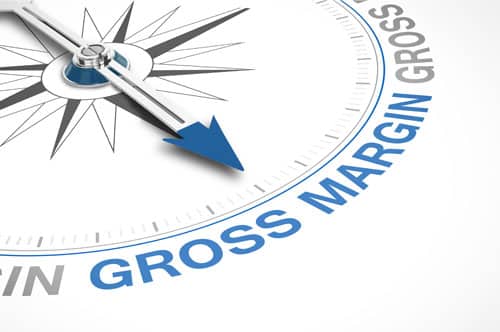
In my opinion, the fault here lies in our human nature. When we hear the word “profit,” we quickly equate that to how much money we actually keep. However, gross profit is more like a company’s operating budget for which to pay for the fulfillment of the goods or services sold. To turn a true profit, the fulfillment costs must be less than the gross profit produced.
To that end, I will now drop “gross profit” and use the term “gross margin” going forward.
Much of this way of thinking has been self-inflicted over the years. In fact, it’s not uncommon for distributors to be overly reliant on gross margin, or more specifically gross margin as a percentage of sales, when measuring the performance of their businesses. Many in our industry believe that it’s the be-all, end-all judgement of a sales professional’s worth and that it’s also readily indicative of a customer’s value to your organization. When you dig a little deeper, however, you begin to see that this time-honored Key Performance Indicator (KPI) is only part of a much bigger story.
Let me be clear: I am not claiming that gross margin percentage is a bad way to measure your business, your team’s performance, or a customer’s value. Without a doubt, it still has a vital place in the evaluation of your success, but by itself, gross margin percentage is of low value. You must always consider the associated dollars.
Gross Margin Percent Alone is Not Enough
Here’s an extreme example: When you get a paycheck, it is made payable in the form of dollars and cents. What if everyone received payroll checks in the form of percentages that were not tied to any specific dollar amount? Utter chaos would ensue.
Now, let’s equate this back into the world of distribution. Even if you earn a high gross-margin percentage on a transaction, the dollar value of that ticket may be paltry, rendering the sale unprofitable.
Why do I mention this? Gross margin production, when considering its value as a KPI, is only half of the profitability equation. The other side is the fulfillment cost, or the cost to serve (CTS). You must ask yourself, what does it cost you to get that margin in the end? To take it a step further, do you readily know the amount and source of fixed versus variable costs for your organization? Knowing this and understanding the associated activity drivers will present the opportunity for next-level business management and EBITDA production.
Based on distributor data collected over the past five years, it is likely that your average cost to serve per order would be at least $50, and possibly even $200 or more. In addition to being a blend of fixed and variable costs, this range of values has a number of other influential factors such as organization size, distribution network type, transaction volume and the ratio of direct ship versus through-stock orders. Now, using this as a generic benchmark, consider how many orders you process each year that have gross margin dollars, let alone revenue dollars, that are below that average CTS threshold; this can be a scary realization for most.
However you calculate it — the more in-depth Activity Based Costing (ABC) method using in-house or third-party software, or a simple, back-of-the-napkin ballpark estimation of the average cost of a typical order — you need to understand the time and money it takes to service your customers.
The Customer Benefits, Too
Believe it or not, this goes well beyond just making sure that your own company makes more money. Due to the reciprocal nature of a supply chain relationship, the customer can feel the positive impact here, as well.
If you identify low-dollar activity with customer X, you can bet that they’re spending low-return time, money and resources with you, too. Every time they ask you for a quote, you spend the time to write it up, and then they spend the time to review it. If they accept, they’ll issue a PO, to which you then respond with a sales order. You then pick, pack and ship the material for them to receive, inspect and use or store it. This activity goes back and forth, step for step in a continuous cycle.
For example, if issuing an RFQ costs the customer $10, responding with a quote may cost the distributor $15. Even though the time, costs and steps vary, both parties agree that they expend some amount of money or effort and that the activities go hand-in-hand. If the goal is to deliver more value and achieve greater productivity together, the total cost of the relationship needs to be more clearly defined and better controlled.
Identify the Risk
So, what’s the primary risk a distribution company faces when focusing too much on gross margin percentage? Taking on undesirable business where the cost to serve outweighs the actual gross margin dollar production. When that happens, the distributor inadvertently misses out on servicing potentially more desirable business (even possibly at a lower GM%) because the available service capacity has already been consumed elsewhere. Also, not knowing “what good looks like” often leads to the misalignment of activities and the presence of undesired behaviors from the sales team. This can yield sub-par bottom-line financial results while the topline may appear just fine or even great.
Without a doubt, gross margin dollars and gross margin percentage are two of the easiest KPIs to measure, and for that, we love them. For many salespeople, they’re also the most prominent numbers on their screens and in their heads (thanks to the traditional compensation models’ sole dependency on them). Still, they’re good measurements, but I hope that by now you agree that they are dependent metrics and should not be used in a vacuum.
So, how do you consider all of this information and have an impact on your and your customers’ bottom line?
Become One with the Data
Take a more holistic view and leverage new or existing CTS data. Use it as a decision-making and performance-evaluation resource in addition to tactfully using traditional gross margin KPIs. Simply put, the best in the business look at all the data available and think critically about how, where and at what price to apply their limited resources so as to maximize the effectiveness and efficiency of their relationships with customers.
Where does that leave us? The first step is to benchmark your current status within your business to identify where you’re spending your time, effort and resources. Comparing those results with the relevant gross margin dollars produced will begin to paint the picture of “what good looks like.” This exercise will give you a window into where you are today, and from there you can begin to adjust your activities, client roster and business development objectives for greater long-term success.
CTA: Learn more about the path to profit by downloading our e-book, “Five Keys to Unlocking Profitable Growth.”

